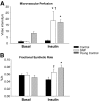Pharmacological vasodilation improves insulin-stimulated muscle protein anabolism but not glucose utilization in older adults
- PMID: 20724580
- PMCID: PMC2963534
- DOI: 10.2337/db10-0415
Pharmacological vasodilation improves insulin-stimulated muscle protein anabolism but not glucose utilization in older adults
Abstract
Objective: Skeletal muscle protein metabolism is resistant to the anabolic action of insulin in healthy, nondiabetic older adults. This defect is associated with impaired insulin-induced vasodilation and mTORC1 signaling. We hypothesized that, in older subjects, pharmacological restoration of insulin-induced capillary recruitment would improve the response of muscle protein synthesis and anabolism to insulin.
Research design and methods: Twelve healthy, nondiabetic older subjects (71 ± 2 years) were randomized to two groups. Subjects were studied at baseline and during local infusion in one leg of insulin alone (Control) or insulin plus sodium nitroprusside (SNP) at variable rate to double leg blood flow. We measured leg blood flow by dye dilution; muscle microvascular perfusion with contrast enhanced ultrasound; Akt/mTORC1 signaling by Western blotting; and muscle protein synthesis, amino acid, and glucose kinetics using stable isotope methodologies.
Results: There were no baseline differences between groups. Blood flow, muscle perfusion, phenylalanine delivery to the leg, and intracellular availability of phenylalanine increased significantly (P < 0.05) in SNP only. Akt phosphorylation increased in both groups but increased more in SNP (P < 0.05). Muscle protein synthesis and net balance (nmol · min(-1) · 100 ml · leg(-1)) increased significantly (P < 0.05) in SNP (synthesis, 43 ± 6 to 129 ± 25; net balance, -16 ± 3 to 26 ± 12) but not in Control (synthesis, 41 ± 10 to 53 ± 8; net balance, -17 ± 3 to -2 ± 3).
Conclusions: Pharmacological enhancement of muscle perfusion and amino acid availability during hyperinsulinemia improves the muscle protein anabolic effect of insulin in older adults.
Figures





Similar articles
-
Insulin stimulates human skeletal muscle protein synthesis via an indirect mechanism involving endothelial-dependent vasodilation and mammalian target of rapamycin complex 1 signaling.J Clin Endocrinol Metab. 2010 Aug;95(8):3848-57. doi: 10.1210/jc.2009-2696. Epub 2010 May 19. J Clin Endocrinol Metab. 2010. PMID: 20484484 Free PMC article.
-
Muscle protein metabolism responds similarly to exogenous amino acids in healthy younger and older adults during NO-induced hyperemia.Am J Physiol Regul Integr Comp Physiol. 2011 Nov;301(5):R1408-17. doi: 10.1152/ajpregu.00211.2011. Epub 2011 Aug 31. Am J Physiol Regul Integr Comp Physiol. 2011. PMID: 21880862 Free PMC article.
-
Pharmacological enhancement of leg and muscle microvascular blood flow does not augment anabolic responses in skeletal muscle of young men under fed conditions.Am J Physiol Endocrinol Metab. 2014 Jan 15;306(2):E168-76. doi: 10.1152/ajpendo.00440.2013. Epub 2013 Nov 26. Am J Physiol Endocrinol Metab. 2014. PMID: 24280127 Clinical Trial.
-
Effect of insulin on human skeletal muscle protein synthesis is modulated by insulin-induced changes in muscle blood flow and amino acid availability.Am J Physiol Endocrinol Metab. 2006 Oct;291(4):E745-54. doi: 10.1152/ajpendo.00271.2005. Epub 2006 May 16. Am J Physiol Endocrinol Metab. 2006. PMID: 16705054 Free PMC article. Clinical Trial.
-
Supraphysiological hyperinsulinaemia is necessary to stimulate skeletal muscle protein anabolism in older adults: evidence of a true age-related insulin resistance of muscle protein metabolism.Diabetologia. 2009 Sep;52(9):1889-98. doi: 10.1007/s00125-009-1430-8. Epub 2009 Jul 9. Diabetologia. 2009. PMID: 19588121 Free PMC article.
Cited by
-
Low-load resistance training during step-reduction attenuates declines in muscle mass and strength and enhances anabolic sensitivity in older men.Physiol Rep. 2015 Aug;3(8):e12493. doi: 10.14814/phy2.12493. Physiol Rep. 2015. PMID: 26265753 Free PMC article.
-
The Microvasculature and Skeletal Muscle Health in Aging.Exerc Sport Sci Rev. 2018 Jul;46(3):172-179. doi: 10.1249/JES.0000000000000151. Exerc Sport Sci Rev. 2018. PMID: 29652695 Free PMC article. Review.
-
Post-exercise Cold Water Immersion Effects on Physiological Adaptations to Resistance Training and the Underlying Mechanisms in Skeletal Muscle: A Narrative Review.Front Sports Act Living. 2021 Apr 8;3:660291. doi: 10.3389/fspor.2021.660291. eCollection 2021. Front Sports Act Living. 2021. PMID: 33898988 Free PMC article. Review.
-
The Etiology of Reduced Muscle Mass with Surgical and Pharmacological Weight Loss and the Identification of Potential Countermeasures.Nutrients. 2024 Dec 31;17(1):132. doi: 10.3390/nu17010132. Nutrients. 2024. PMID: 39796566 Free PMC article. Review.
-
Reactive hyperemia is not responsible for stimulating muscle protein synthesis following blood flow restriction exercise.J Appl Physiol (1985). 2012 May;112(9):1520-8. doi: 10.1152/japplphysiol.01267.2011. Epub 2012 Feb 23. J Appl Physiol (1985). 2012. PMID: 22362401 Free PMC article. Clinical Trial.
References
-
- Park SW, Goodpaster BH, Lee JS, Kuller LH, Boudreau R, de Rekeneire N, Harris TB, Kritchevsky S, Tylavsky FA, Nevitt M, Cho YW, Newman ABHealth, Aging, and Body Composition Study Excessive loss of skeletal muscle mass in older adults with type 2 diabetes. Diabetes Care 2009;32:1993–1997 - PMC - PubMed
-
- Bennet WM, Connacher AA, Scrimgeour CM, Jung RT, Rennie MJ. Euglycemic hyperinsulinemia augments amino acid uptake by human leg tissues during hyperaminoacidemia. Am J Physiol 1990;259:E185–E194 - PubMed
-
- Bennet WM, Rennie MJ. Protein anabolic actions of insulin in the human body. Diabet Med 1991;8:199–207 - PubMed
Publication types
MeSH terms
Substances
Grants and funding
LinkOut - more resources
Full Text Sources
Medical
Miscellaneous

